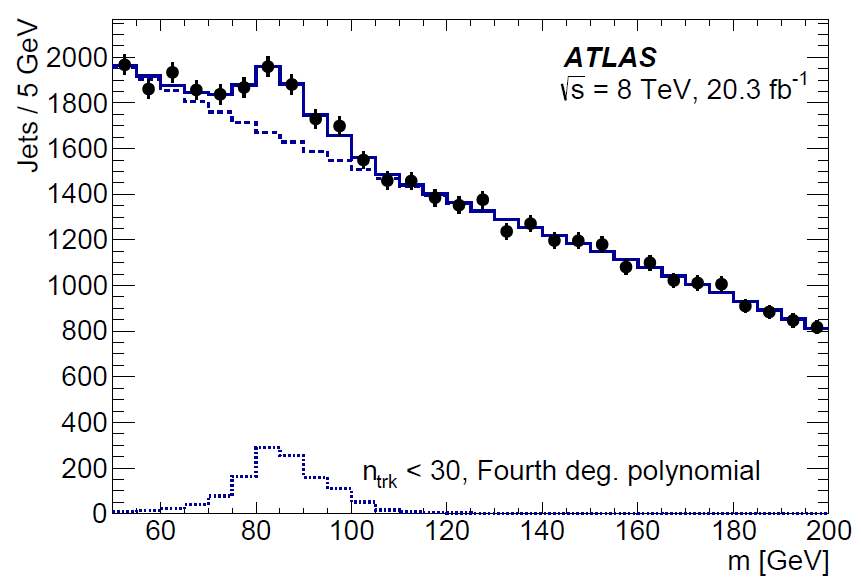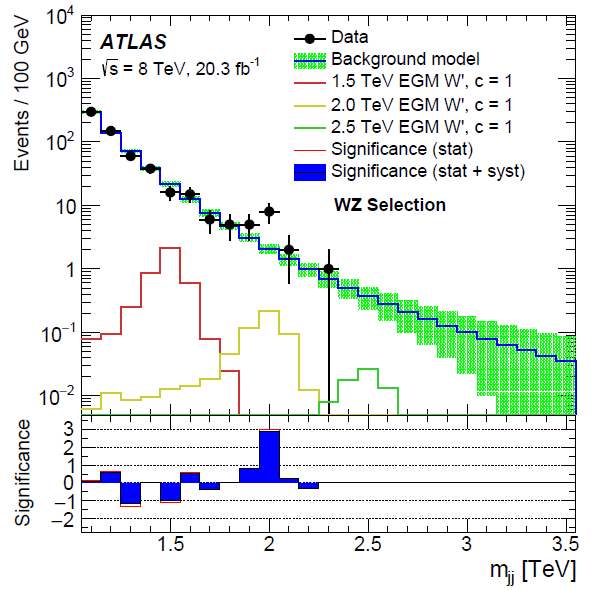Now I regret that, and I am trying to fill that void in some way. The occasion is a new article which appeared in the ArXiv the other day, titled "2 TeV Walking Technirho at the LHC?". The article is rather technical in its contents, as it illustrates the way the model could hold water and explain the 2 TeV anomalous signals unearthed by ATLAS, its features and rate. So maybe we can start by going back to the original ATLAS signals that triggered these theoretical studies.
The ATLAS search exploits the recent advances in the identification of hadronic decays of highly boosted vector bosons. Those advances have revolutionized the whole field, thanks to the large energy of LHC collisions and the consequent interest of detecting W and Z bosons of high momentum.
W and Z bosons decay a large fraction of the times into quark-antiquark pairs (45% and 69% of the time, respectively), but if you look around for vector-boson physics results, you will mostly find results based on the electron or muon final states (whose decay rates are 11%/11% and 3.3%/3.3% to electron/muon final states, respectively). Why is that ? Because quark-antiquark final states cannot be distinguished from the huge background of processes originated by strong interactions, the dreaded "QCD background" - hence one uses leptonic final states for measurements.
The above picture has changed with the advent of the new techniques. When two quarks from the decay of a W or Z boson merge together into a single "fat" jet, being "pushed" together by the large momentum of the decaying parent, they are more distinguishable from the QCD background, which hardly produces such fat jets. The distinguishing feature of the two "sub-jets" that the two quarks give rise to within the fat jet is of course their combined invariant mass -which is in the 80-90 GeV ballpark; the large energy of the boosted objects make the mass a good resolution quantity, if proper "jet-grooming" techniques are applied to clean up the sub-jet signals from all the surrounding mess of hadronic activity that may be present in a wide energy deposit in the calorimeter.
For a guy like me, who has been around for enough time to be enthused by the early hadronic signal of W and Z bosons extracted at the SppS collider in the late eighties (a signal so tiny over the QCD background that you needed a lot of faith to believe in), and who has spent three years of his life to extract a very faint signal of Z->bb decays in dijet events at CDF in the late nineties, seeing something like the graph below is extraordinary.

Above you can see a combined W and Z signal in ATLAS fat jets - a clear demonstration that these signals have become a very workable tool. The data (black points with error bars) show a clear peak at the mass of the vector bosons.
The use of these hadronic W and Z bosons is straightforward in the search for heavy resonances which might decay to a pair of vector bosons: you look for two energetic fat jets recoiling one against the other, reconstruct the W and Z signals within them, clean them up, and you are ready to produce a distribution of the invariant mass of the tentative object which produced the pair of vector bosons. I am of course simplifying the whole process quite a bit, but that's more or less what is done to produce the graph below.

What you can see is that there are not gazillions of events that satisfy the requirements: the background dies out pretty quickly at large invariant mass of the pair of bosons. Hence the search can be sensitive to a possible resonance. And ATLAS does see a "peaking structure" in the histogram (I am only showing one of the three possible histograms that one may extract from the data making different assumptions on whether the two bosons are a WW, a WZ, or a ZZ pair).
The peak at 2 TeV has a global significance in the 2.5 sigma ballpark. This "global" adjective requires some explanation: it is the result of asking the question "what is the significance that I would see a signal at least this strong in this analysis, anywhere in the investigated spectrum?". Of course, this is a more meaningful question to answer than the one of just assessing what is the chance that the background fluctuates at exactly 2 TeV, as we did not have any a priori interest in exactly that mass value.
One could take a different stand though: take e.g. the whole Exotics group of the ATLAS collaboration. They have produced a hundred of searches in the Run 1 LHC data. If one analysis reports a "global" 2.5 sigma significant signal, how likely it is assuming all analyses are only seeing backround ? Of course not so high: if you constructed a thousand replicas of the Exotics group in ATLAS, and gave to each of these groups a different set of data (all background-only), the chance that one of them came up with a 2.5 sigma signal would be of the order of 50%. This is a back-of-the-envelope argument, but it illustrates how hard it is to give "significance" to significance estimates.
Now, let me mention the theoretical paper of Fukano, Kurachi, Matsuzaki, Terasi, and Yamawaki. They study a model called "walking technicolor" which was much more en vogue in the nineties than it is today, as its simplest realizations have been disproven already with Tevatron data. I cannot discuss the model in detail here, but in extreme summary, the authors showed that their model is consistent with the excess that ATLAS observes in the ZZ channel. They indicate that ATLAS has the possibility of discriminating the ZZ from the WW/WZ hypothesis sufficiently to distinguish the different possibilities. They also noted that the LHC run 2 will be able to test the hypothesis also using the leptonic channels.
Of course, ATLAS and CMS will not sit on their data for long - these diboson analyses have become a high priority for the experiments. So, let us cross fingers and wait for good news - or for just another exclusion of a former exciting fluctuation...





Comments